Visual Tutorial
Bank Reconciliation
Introduction
We usually associate a bank reconciliation with a company’s checking account. In accounting, a company’s checking account is part of the cash that is reported on the company’s balance sheet.
The bank reconciliation can take place on any day. However, it is important that it be done as of each balance sheet date.
The bank reconciliation is a process of reconciling these two items:
- The bank’s balance for the company’s checking account
- The company’s general ledger balance for the same checking account.
This process of reconciling the bank’s balance and the company’s balance for the checking account has various names. Here are some of them:
bank reconciliation
bank rec
bank statement reconciliation
reconciling the bank statement
Importance of the Bank Reconciliation
It is common for a company to process thousands of payments and receipts each month. As a result one can expect that a few items will be recorded incorrectly or might be omitted. The bank reconciliation process seeks to detect and correct such errors and omissions.
For each error involving the checking account there will also be an effect on another general account due to the double-entry system of bookkeeping or accounting. For instance, if a bank service charge or fee is omitted, the company’s cash and one of its expenses will be incorrect. In turn, the company’s assets, net income, retained earnings, working capital, current ratio, and more will be incorrect.
The bank reconciliation is also an important part of a company’s control over its cash. That control is further enhanced when the bank reconciliation is done by someone other than the person writing the checks and recording deposits.
The bank reconciliation should result in the correction of an incorrect cash balance in the company’s records. By having the correct checking account balance the company may avoid overdrawing its checking account and the negative effects that may result (overdraft fees, returned checks to suppliers, harm to its credit worthiness, etc.).
How the Bank Reconciliation Works
Assume that a company issues 100 checks every month. Each of those checks will be entered immediately in the company’s general ledger accounts. However, it may take days or weeks for some of those checks to make their way back to the company’s bank account. As a result, the balance at the bank will be different from the balance in the company’s general ledger account.
Checks written by a company usually do not clear their bank account on the same day. Therefore, the bank balance will not be the same as the amount in the company’s cash account.
A company’s receipts should be recorded in the company’s accounts as of the date that the money is received. However, the receipts may be recorded in the bank account on the following business day. This will cause the balance in the bank account to be different from the amount in the company’s general ledger.
If a company does not make a bank deposit by a certain time, the bank will record the deposit as of the next business day. This will result in a difference between the bank balance and the balance in the company’s general ledger account.
Some transactions are recorded by the bank before the company records them in its general ledger accounts.
Examples include:
- Bank service charge
- Check printing fees
- Checks that were previously deposited by the company but are now returned because of insufficient funds
- Electronic deposits from credit card transactions.
Until these transactions are recorded by the company, there will be a difference between the balance in the bank account and the balance in the company’s accounts.
Some transactions are recorded in the bank account before the company makes an entry in its general ledger accounts. This will cause a difference between the balance at the bank and the balance in the company’s general ledger account.
The previous slides pointed out that:
- The bank balance is probably not the true or correct amount, and
- The company’s general ledger balance is probably not the true/correct amount
The bank reconciliation is a process to determine the one true/correct balance.
It is likely that neither the balance on the bank statement nor the balance in the company’s accounts is the true/correct amount.
The bank reconciliation is a process to determine the one true/correct balance for a checking (or other) account.
There is more than one way to reconcile the bank statement balance. We will use the format referred to as correct balance method or adjusted balance method. Under this method, both the bank’s balance and the balance in the company’s general ledger will be adjusted to the one true/correct amount.
We will use the correct balance method for reconciling the bank account. This means that both the bank’s balance and company’s general ledger balance will be adjusted to the true/correct amount.
The balance shown on the bank statement and in the bank’s records is referred to as the balance per bank, or the unadjusted balance per bank.
The balance in the company’s general ledger for the bank account is referred to as the balance per books, or the unadjusted balance per books.
The balance per bank will need to be adjusted for items that are in the company’s records but are not yet in the bank’s records.
Here is the format for adjusting the balance per bank:
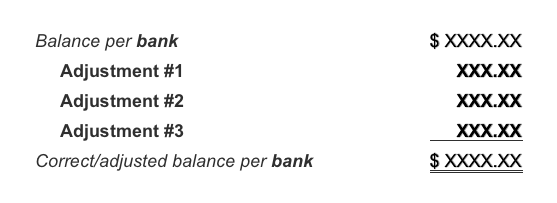
The balance per books will need to be adjusted for items that are in the bank’s records but are not yet in the company’s accounting records.
Here is the format for adjusting the balance per books:
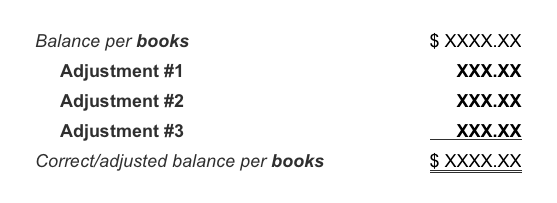
The bank reconciliation is complete when you have the following:
Correct/adjusted balance per bank
is equal to the
Correct/adjusted balance per books
Adjustments to the Balance per Bank
Recall that the balance per bank must be adjusted for the items that are in the company’s records but are not yet in the bank’s records.
The most common adjustment to the balance per bank is the amount of the checks that have been written by the company but have not yet cleared its bank account. These are referred to as outstanding checks.
The amount of outstanding checks is deducted from the balance per bank:

Another adjustment to the balance per bank will be the money received by the company but not yet appearing in the bank’s records. These are known as deposits in transit. They may result from a retail store depositing each day’s receipts in the bank’s night depository after the normal banking hours or at the bank on the following morning.
The deposits in transit are additions to the balance per bank:

A third possibility for an adjustment to the balance per bank is a bank error.
Depending on the bank error, it could be an addition or a subtraction from the balance per bank:
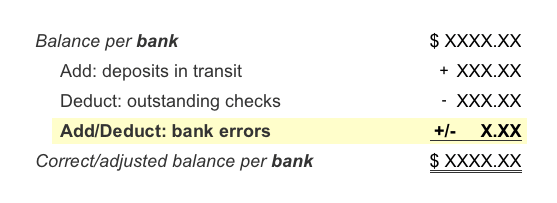
Adjustments to the Balance per Books
We will now discuss the balance per books. This is the balance in the company’s general ledger for the checking account.
The balance per books will need to be adjusted for items that are already in the bank’s records but are not in the company’s records. The bank’s monthly service charge is an example of a deduction to the balance per books:

The adjustments to the balance per books will need to be entered into the company’s general ledger accounts.
In the case of a bank service charge of say $27, the company will need to credit its Cash account for $27 and also debit an expense account such as Bank Service Charges Expense for $27.
Adjustments to the balance per books will require an entry (a debit and a credit) to the company’s general ledger accounts.
Occasionally the bank will charge the company’s checking account for a check that the company deposited earlier but it is now being returned as NSF (not sufficient funds in the checking account of the person writing the check).
Since the amounts are already deducted on the bank’s records, these will be a deduction to the balance per books.

Recall that the adjustments to the balance per books will need to be recorded in the company’s general ledger. If the NSF checks were received from customers paying an amount owed on a previous purchase, the company will need to debit Accounts Receivable and credit its Cash account.
In the case of NSF checks, the Cash account is credited and another account will need to be debited.
Besides deductions, the bank may have increased the checking account balance without notifying the company. For example, there may have been an electronic transfer of funds into the checking account from one of the company’s customers or from a credit card processor.
The two items mentioned will be additions to the balance per books:

As usual, the adjustments to the balance per books must be recorded in the company’s general ledger accounts.
It is also possible that the bank increased or decreased the company’s checking account for an error the company had made on one of its bank deposits.
A company error on one of its bank deposits will be an adjustment to the balance per books.

Any error by the company needs to be corrected in the company’s general ledger accounts.
Here are a few words that can assist you in preparing the bank reconciliation:
“Put the item where it isn’t.”
An outstanding check is already on the company’s books, but it isn’t on the bank statement, so put the outstanding check as an adjustment to the balance per bank.
A deposit in transit is already on the company’s books, but it isn’t on the bank statement, so put the deposit in transit as an adjustment to the balance per bank.
A balance service charge, check printing fees, and credit card deposits are already on the bank statement, but they are not on the company’s books, therefore you list them as adjustments to the balance per books.
Any adjustments to the balance per books will require the company to make a journal entry into its general ledger accounts.
Any adjustment to the balance per books will require a journal entry in the company’s general ledger. The entry will involve Cash and another general ledger account.
Since you cannot make an accounting entry in the bank’s general ledger, you do not prepare a journal entry for any adjustment to the balance per bank.
However, the adjustments to the bank balance will need to be resolved with the bank.
Any adjustment to the balance per bank will require communication with the bank to resolve the issue.
Recap of What We Have Covered to this Point
- The balance on the bank statement is probably not the true balance because of outstanding checks and perhaps deposits in transit.
- The balance in the company’s general ledger cash account is probably not the true balance because of the bank service charge and other items on the bank statement that have not been recorded in the company’s general ledger.
- There could be an error in the company’s records and/or in the bank’s records.
Recap of What We Have Covered to this Point (cont’d)
- The method we used adjusts both the balance per bank and the balance per books to be the same true or correct amount.
- Adjustments to the balance per books will require journal entries in the company’s general ledger accounts.
We will use a series of transactions to illustrate the correct/adjusted balance method for reconciling the bank statement. The first transaction is the owner’s deposit of $900 to open the company’s checking account on December 1. Both the general ledger accounts (books) and the bank show the balance of $900.
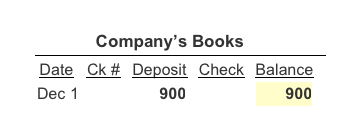
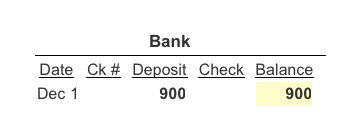
Since both the balance per books and the balance per bank are the same, we state that the bank statement is reconciled as of December 1.
On December 2, the company issues its check #1 for $80 and mails it to the payee. As of December 2, the balance per books is $820 and the balance per bank is $900.
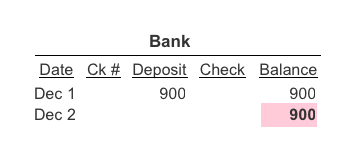
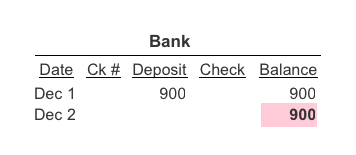
Bank Reconciliation as of December 2
Since the balance per books is $820 and the balance per bank is $900, we need to reconcile the difference.
Recall our earlier advice of “put the item where it isn’t.” Since check #1 is already on the books, but it isn’t on the bank statement, we list the outstanding check as an adjustment to the balance per bank:

On December 3, the company receives $50 from a customer, however it is recorded by the bank on the next day. Since the $50 was a December 3 receipt, it is recorded in the general ledger as of December 3. Since the bank processed the deposit on December 4, the bank’s records as of December 3 will not show the $50 deposit:
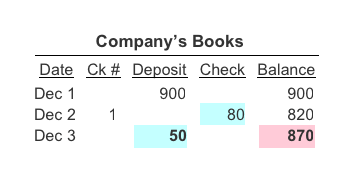
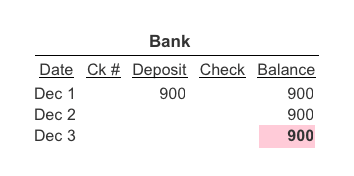
Bank Reconciliation as of December 3
Since the receipt of December 3 is on the company’s books, but it isn’t in the bank’s records as of December 3, this deposit in transit is an adjustment to the balance per bank. Since check #1 has not yet cleared the bank as of December 3, there will be two adjustments to the balance per bank:

On December 4, the company does not write any checks or receive any money. However, the bank processed the company’s $50 deposit.
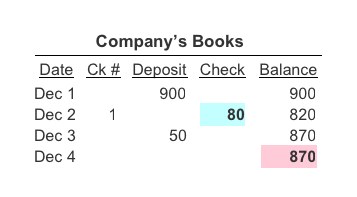
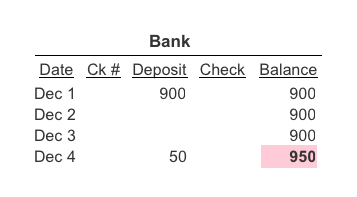
Bank Reconciliation as of December 4
Since check #1 has not cleared the bank as of December 4, it will continue to be listed as an adjustment to the balance per bank. Note that after the adjustment for the outstanding check, the bank reconciliation shows the correct balance of $870 for both the books and the bank.

On December 5 the company writes check #2 for $60 and mails it to the payee. There were no receipts and no other payments.
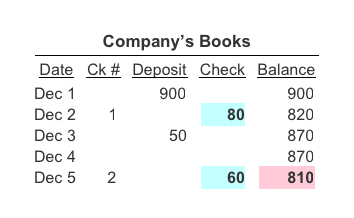
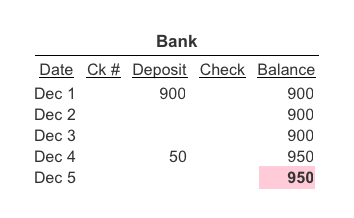
Bank Reconciliation as of December 5
Since neither check #1 nor check #2 have cleared the checking account at the bank, both checks are adjustments to the balance per the bank as of December 5:

On December 6, the bank charges the company’s checking account $44 for the printing of the checks that the company had ordered through the bank.
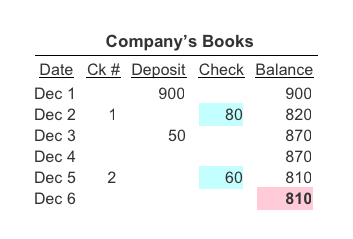
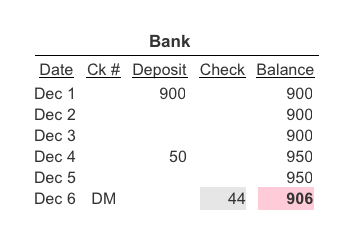
The bank charge (noted as DM for debit memorandum) of $44 appears on the bank’s records, but wasn’t on the company’s books. Therefore the $44 charge will be an adjustment to the balance per books:

Since the adjusted balance per books and the adjusted balance per bank agree, we say the bank statement has been reconciled.
Recall that an adjustment to the balance per books will require an entry to the company’s general ledger accounts. Therefore, the company needs to enter as of December 6 the check printing charge of $44. The entry will be a $44 credit to the Cash account and a debit of $44 to an account such as Supplies Expense, Check Printing Expense, or Miscellaneous Expense.
An adjustment to the balance per books will result in:
- A credit to Cash when the bank account was decreased and a debit to another account.
- A debit to Cash when the bank account was increased and a credit to another account.
Practice Bank Reconciliation #1
Let’s prepare a bank reconciliation using the following information as of November 30:
Balance in the general ledger for the checking account $40; balance in the bank’s records (bank statement) $450; deposits in transit $200; outstanding checks $625; bank service charge $15.

Practice bank reconciliation #2
Next, let’s prepare a bank reconciliation using the following information as of December 31:
Balance in the general ledger for the checking account $330; balance in the bank’s records (bank statement) $725; deposits in transit $100; outstanding checks $600; bank service charge $10; NSF check of $75; NSF check fee $20.

The End
There are more resources to assist you under our topic Bank Reconciliation.
Turn on study mode to focus
Bank Reconciliation Outline
- Read our Explanation (3 Parts) Free
- Take our Practice Quiz Free
- Review our Visual Tutorial
- Review our Flashcards
- Solve our Word Scramble Free
- Solve our Crossword Puzzle #1 Free
- Solve our Crossword Puzzle #2 Free
- Solve our Crossword Puzzle #3 Free
- Review our Sample Business Forms
- Review our Cheat Sheet
- Take our Quick Test #1
- Take our Quick Test #2
- Take our Quick Test #3 with Coaching
- Earn our Bank Reconciliation Certificate of Achievement
Learn How to Advance Your Accounting and Bookkeeping Career
- Perform better at your current job
- Refresh your skills to re-enter the workforce
- Pass your accounting class
- Understand your small business finances
Featured Review
"I am a small business accountant and tax preparer. A lot of my clients are do-it-yourself bookkeepers for their small business. Most of them, if not all, use bookkeeping software to keep track of their business. Although software programs are great at what they do and are easy for the user, the double entry accounting method is still occurring in the background. Accounting concepts and terms are not easily explained to a small business owner who doesn't understand why reports look the way they do. To help them, I always direct them to AccountingCoach to learn the concepts and terms. The tutorials, glossary, and web topics are presented in the best way that anyone can understand accounting. It's the best source on the web!" - Kathleen F.




